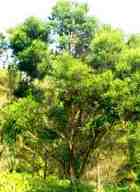
Plant Part: Leaves
Extraction: Steam Distilled
Growing Practice: Ethical
Country of Origin: Australia
Odor Type: CAMPHOROUS
Tea tree essential oil is antibacterial, antiviral, and antifungal, as well as an effective immuno-stimulant and anti-inflammatory.
Odor Characteristics: Tea Tree Essential Oil has a spicy camphoraceous odor, with an occasional whiff of citrus if fresh (Lis-Balchin). Arctander describes it as "a warm-spicy, aromatic-terpenic odor, reminiscent of numeg, cardamom and sweet marjoram, but with a strong emphasis on the terpinene- and terpinenol-notes.... The flavor is warm-aromatic, somewhat burning, spicy and yet fresh, faintly camphoraceous, slightly bitter."
Refractive Index: 1.47500 to 1.48200 @ 20.00 °C.
Specific Gravity: 0.88800 to 0.90900 @ 25.00 °C.
Appearance: pale yellow to yellow clear liquid
BioChemical Class: Monoterpene, Alcohol
BioChemicals:
| Sample ID | ISO 4730 | |
| Laboratory No. | ---- | |
| Constituent | Percent | |
| α-pinene % | 2.44 | 1 - 6 |
| sabinene % | 0.69 | tr - 3.5 |
| α-terpinene% | 10.64 | 5 - 13 |
| limonene % | 0.87 | 0.5 - 1.5 |
| p-cymene % | 1.42 | 0.5 - 8 |
| 1,8-cineole % | 2.61 | tr - 15 |
| γ-terpinene % | 21.37 | 10 - 28 |
| terpinolene % | 3.48 | 1.5 - 5 |
| terpinen-4-ol % | 40.84 | 30 - 48 |
| α-terpineol % | 2.78 | 1.5 - 5 |
Batch WDN-01
CAS No: 68647-73-4
Flash Point °F: 140
About the Plant
Melaleuca alternifolia commonly known as the Narrow-leaved Paperbark or Narrow-leaved Tea Tree and sometimes as "ti tree" is a tall tree or shrub in the Family Myrtacae. It grows in the wild along streams and swampy flats in Queensland and New South Wales, Australia. Commercial plantations were established in the 1970's and 80's. Plantations are established from greenhouse-grown seedlings and are planted in high density. After 1-3 years, the whole plants are cut down and chipped into small fragments.Tea Tree Oil is produced through steam distillation of the leaves and branches, with a yield of 1-2% by weight of wet plant material.
History
The aromatics from crushed "Tea tree" leaves were used by the Bundajalung people of eastern Australia to treat respiratory ailments; the crushed leavers were used as a poultice for woulnds and skin ailments. By the 1920's the medicinal properties of tea tree essential oil were discovered by Penfold, and the oil was distilled in the wild in bush stills. Although production ebbed after WW2, interest was revived in the 1970's and commercial plantations were established. Terpinene-4-ol is believed to be responsible for most of the antimicrobial activity.Perfumery: When Arctander wrote in 1961 he stated that "the oil has been gathering an increasing interest for its warm-spicy, aromatic and fresh character ... Which has ... Become particularly popular since the introduction of spicy colognes and after-shaves for men."
Carson et al have a comprehensive review of Antimicrobial and Other Medicinal Properties here.![]()
The RIFM recommended safety of use limit is 1%. [This apparently applies to cosmetic use, and is controversial (per Cropwatch).]
The information provided on these pages is not a substitute for necessary medical care, nor intended as medical advice. Always keep aromatic extracts tightly closed and in a cool, dark place, out of reach of children. Never ingest aromatic extracts. Always dilute aromatic extracts when applying topically and avoid areas around eyes or mucous membranes. If redness or irritation occurs, stop using immediately and contact your health provider if necessary.![]()
all images and content copyright ©2000—2020 by suzumebachi design and samara botane





